Animals on the Move
This month (November 2020), we're theming our shows around movement. From cells moving at one extreme, to planetary movements at the other! And this week we’re kick-starting the series by talking animal movement: migration, monitoring, and when to intervene in how animals move. Plus in the news - What do falling levels of coronavirus antibodies in those infected say about the likely success of a vaccine? Why might we want to dose ourselves with vitamin D? And why the Moon’s wetter than we first thought!
In this episode
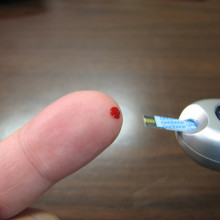
01:05 - How long do Covid-19 antibodies last?
How long do Covid-19 antibodies last?
Wendy Barclay, Imperial College London
Cases of coronavirus are surging again across Europe. In France Emmanuel Macron has announced another lockdown; Germany are hot on their heels with a lockdown “lite”, and Belgium currently has the world’s highest per capita rate of coronavirus infections. And England has recently heard news of another lockdown coming into effect on 5th November. The sombre situation looked gloomier still earlier in the week when a study of the population’s Covid antibody levels was published. We had hoped early in the pandemic that testing for antibodies would reveal that many people had already had the new coronavirus, perhaps without even realising it, and that they would remain immune.Unfortunately those tests showed that, so far, fewer than 10% of us appear to have been infected, which is too low to make a difference to how the virus spreads in the community. More damning still were the follow up study results out this week looking at how long people are hanging onto those antibodies afterwards: they fall away fast, meaning people may well become susceptible again to infection within just months. So, alarm bells began to ring for many who were concerned about the implications of the findings for a Covid-19 vaccine. Chris Smith spoke to Wendy Barclay…
Wendy - This study is called REACT. It's a huge study in which we ask people in the United Kingdom to do a home test. So we posted out one of these finger prick blood tests, and people did that in their own home, took a photo and sent it back to us. And over the three rounds that we did this in July, August, and September, more than 350,000 people did that.
Chris - And when you then compare the results that come back, this is really a yes or no answer, "have you got antibodies against coronavirus?" what came back?
Wendy - In the first round we found that 6% scored positive on the test. It's a yes-no answer. As you say, and that means yes, they had antibodies to the SARS-Cov2 virus. We've already checked this test is quite specific. That means that sometime between January and July, they will have been infected with the virus. When we looked again in August and September, the percentage of the random people that had been selected for those rounds who had a positive score in the test was lower. And by the time we got to the beginning of September only 4.4% of the people had those antibodies, which is if you calculate it, about a 26% decrease.
Chris - Does a negative test then therefore mean a person can regard themselves as back to immunological "point-zero", or do you think they still have some degree of immunity? So were they challenged again with the virus, their immune system would actually have a head start?
Wendy - I think there are two questions here to sort of pull apart. One is how much antibody does a person need in their blood to be considered immune. There are some studies in non-human primates where vaccines have been given and then animals have been challenged and you can begin to see how much antibody didn't confer protection. So then you can begin to sort of put a benchmark in. And we actually think that there's quite a good correlation between the point at which you cross the threshold of no longer scoring positive, and the titre of antibody that you would need to have in order to be considered immune. So from that point of view, it's quite worrying because it does say that once a person no longer scores positive, they haven't got the amount of antibody that we think they need to be protected. But on the other hand, as we all know, your immune response has memory, and once you've seen a pathogen, once you are in a better place to respond to it again. And without a doubt that prior exposure to SARS-Cov2 ought to mean that most people, even if they've lost their antibody that's circulating in their blood, have a head start, which probably means they might get infected, but hopefully less severely so.
Chris - What would be the implication then for a vaccine?
Wendy - We have to remain optimistic. Vaccines work in completely different ways from natural immunity, most viruses have evolved ways of evading their hosts immune response. It's a hypothesis that I have that coronaviruses may be quite good at stocking the antibody response working as well as it might otherwise do. And in that case, it might fall away more quickly perhaps than a vaccination with a very powerful vaccine could lead to longer lasting antibodies.
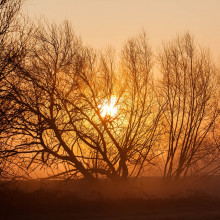
05:51 - Could vitamin D help with Covid?
Could vitamin D help with Covid?
David Thickett, University of Birmingham
As we’re heading into winter here in the Northern hemisphere, and if you’re spending rather more time inside your home at the moment, you’re probably not getting as much sunlight on your skin as in the summer months. And the body actually uses sunlight to make vitamin D, which is important for healthy teeth, bones and muscles. This week, a paper published in The Lancet: Diabetes and Endocrinology has looked at whether levels of vitamin D may be related to how someone might fare with Covid-19. And Chris Smith spoke to respiratory physician David Thickett, who wasn't involved in this study…
David - There are several strands of evidence that point to vitamin D protecting against viral respiratory infections. And there are similarities between the patterns of infection across the globe between the coronavirus seasonal influenza and the swine flu pandemic, whereby the greater the distance you move from the equator, the higher the case rates for those viral infections, which has implicated sunlight exposure, and potentially vitamin D deficiency is one of the possible causes of that.
Chris - What does it actually do to the immune system though? Because most people will be familiar with vitamin D in terms of its role in maintaining healthy bones and skeleton. So what's it got to do with immunity?
David - It's actually a very broad acting steroid hormone. It affects a very large number of cells outside of the bone, which is the classical actions of vitamin D, but it's certainly been implicated in immune health. Blood cells, such as lymphocytes respond to the vitamin D. And also other organs, such as the heart muscle strength, has been linked to having a good level of vitamin D. So it's a fairly protective hormone and very wide effect, which potentially have some advantages in the sort of severe lung injury that COVID pneumonia causes.
Chris - Presumably then someone has done the obvious experiment where they've measured vitamin D levels and then they've looked at people who have, or haven't had, severe infections with coronavirus and have tried to marry the two together?
David - Yeah. So we've done that pre-coronavirus. What Covid patients get is something called the acute respiratory distress syndrome, which is the very severe lung inflammatory response. And it can be due to pneumonia, viral pneumonia. You can get it after trauma or smoke inhalation, those sorts of things. And we'd shown that levels of vitamin D are very low in people who develop that syndrome. And gradually as the pandemic has gone on more and more papers have been published saying that this is possibly the same with coronavirus infections.
Chris - So, to answer my question then, is there data yet linking vitamin D levels when people are challenged with coronavirus and whether or not they do get severe Covid?
David - Yeah, basically the vitamin D deficiency is very common in Covid patients. And there are a number of papers that have come out recently that implicate it in the severity of the exaggerated immune response, but most of the studies are quite small. They have a limited number of controls, which there are some issues with because of the difficulties of doing this sort of research during a pandemic.
Chris - Obviously one other explanation is that it's just that other lifestyle factors that happen to be there alongside a low level of vitamin D are what's really causing the increased risk, and that the vitamin D is just an innocent bystander.
David - Yeah. So I mean, those studies are all observational. There are no large trials of treating Covid patients with vitamin D, but there is one trial called the Cordoba study and that study did show some positive responses to vitamin D treatment.
Chris - Are we in some respects treating the wrong people if we come in with vitamin D once a person is sufficiently unwell to have come to the notice of a doctor? Would it not be potentially more effective to give people supplementation with vitamin D before they even become infected with coronavirus? Because A that would help the fact that it looks like people who live in countries like ours across winter are chronically short of this important vitamin anyway, but also they would be therefore in better shape to cope with coronavirus if they caught it?
David - Well, I think there are two aspects - is vitamin D abuse as a preventative agent, and is it useful as a treatment once you've got Covid. In terms of prevention, there is evidence that it reduces viral respiratory tract infections. It's not huge, 12% reduction probably in the number of infections, but it may also impact the severity. So the government recommends 400 units a day during the winter, but that's probably an underestimate of what is needed. But there aren't any trials to show that giving vitamin D to prevent coronavirus, currently, where the results are available. Though one has been started in the UK very recently, it won't report 'til the spring at the earliest.
Chris - What are your instincts telling you? Do you think that we're going to end up in a position where it will turn out, actually, this is quite a useful intervention. And given that most of us are vitamin D deficient across winter in high latitudes, it wouldn't do any harm to advise people to just up their vitamin D intake anyway?
David - Yeah, I mean, I'm taking 4,000 units a day. Most of my consultant colleagues who work in intensive care in Birmingham are already taking vitamin D supplements. It's particularly important I think if you're of non-Caucasian ethnicity, those individuals are at much higher risk of vitamin D deficiency. So in targeted individuals, it could be extremely effective, I think, and you know, I'm taking it. And I recommend it to my patients when I find they're vitamin D deficient.
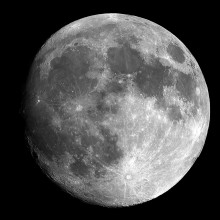
11:26 - New evidence of water on the moon
New evidence of water on the moon
Casey Honniball, NASA
Astronomers this week made the startling discovery of water on the sunlit side of the moon! It’s not the first water we know about up there - there’s ice in the cold, shaded craters at the poles, and incredibly tiny amounts of water gas above the surface - but nobody expected it to survive in the heat of the sun. Speaking with Phil Sansom, NASA’s Casey Honniball explained how she’s made something of a scientific splash with the discovery of what they say are the unmistakable infrared signals of trace water...
Casey - We used a camera that can see infrared light. It flies at 45,000 feet in the atmosphere, which is above commercial airliners.
Phil - What's the point? Why not just have a camera here on earth?
Casey - The Earth's atmosphere completely blocks any light from the 6 micron fingerprint that we're specifically looking for to detect the water molecule.
Phil - So when you say it's a 6 micron fingerprint, do you mean some radiation that has a wavelength of 6 microns that only water emits out?
Casey - That is correct.
Phil - Why hasn't anyone looked for this before?
Casey - You know, I asked myself this question all the time. I think the reason we never looked at it before is because we thought the moon was supposed to be dry. It wasn't until about a decade ago that we found there was some hydrogen-bearing species and it could have been in the form of the water molecule or its close cousin hydroxyl, which is just a hydrogen atom and an oxygen atom. But we didn't really believe that the water molecule itself could be on the sunlit surface of the moon.
Phil - Why not? Why couldn't it be on the sunlit side?
Casey - The lunar environment itself is very harsh. And so we thought that any water that would be present would be lost to space, or it would migrate away to these cold polar regions on the moon.
Phil - I mean, what was your reaction then when you actually saw the signal that means, yes, there's water there?
Casey - I was quite surprised and excited and shocked. I'm pretty sure I screamed at my advisor on the phone!
Phil - What's the explanation then? Because you've just told me that people didn't think it was possible to have water existing on this sunlit side.
Casey - What we believe is happening is that somehow the water is being shielded from the harsh lunar environment. And our current ideas are that the water is stored inside impact glasses. An impact glass is formed when a micrometeorite impacts the surface of the moon. It melts part of the lunar soil, and it can either form molecular water or it can deliver some water, which will then be stored into this melt, which when the melt cools, it creates this impact glass.
Phil - Is it sort of water trapped in tiny glass crystals?
Casey - Yeah, exactly.
Phil - Could it also be there as ice sheltered somehow? Because there's another paper that was released at the same time as a pair with yours, that was saying that based on some scientists modelling, they think that ice can exist in tiny little cold traps inside the moon.
Casey - I like to think about it as our two papers present two different types of reservoirs for water. The water that we are seeing could not be due to it being stored in a micro cold trap. And that's because these micro cold traps are so cold and they're so dark, they don't emit any light at the 6 microns that we're looking at.
Phil - Oh, okay. So you've got your water that you've sensed, which you think is in these tiny glass crystals, and you've got this other paper, which is doing some, some modelling, which thinks that you can have little bits of ice. Between all this prospect of water, how much water are we talking about?
Casey - From our observations, what we estimate is on the surface is about 100 to 400 parts per million of water. And to kind of put that into a little bit of perspective, the sand in the Sahara desert has a hundred times more water present than on the lunar surface.
Phil - Oh my God. When you talk about water on the moon, I thought you meant more than that!
Casey - Yeah. Unfortunately we're not talking about puddles!
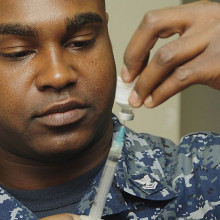
16:25 - Economics of Covid vaccine
Economics of Covid vaccine
Marco Hafner, RAND Europe
Everyone’s praying for a vaccine against the coronavirus. But when it finally comes, who gets it? And how much will they have to pay? It’s not the first time we’ve talked about this crucial issue, and there’s a number of moral arguments to be made, but now economists from the research organisation RAND Europe have predicted the economic impacts of one country keeping the vaccine for themselves. Marco Hafner led the modelling and he spoke to Phil Sansom...
Marco - We did a lot of economic modeling under different scenarios, but in one scenario we found that if, for instance, only those countries or regions, which are currently developing a vaccine, and can also have the potential to manufacture that scale, like the European union, the UK, the US, China, Russia, and India, if only those countries would have initially access to vaccine, and can immunise their populations efficiently, the global economic costs would still be about 1.2 trillion every single year.
Phil - Really? Why?
Marco - So this is because, what we model in our study is, we look at COVID-19 induced, reduced activity, in service sectors with close physical proximity, such as the hospitality sector, the recreation sector, but also transportation. So reduced activity in those sectors can have negative consequences for countries across the globe.
Phil - Oh, so you're saying that because economies rely on the service industry, on tourism, on other things, then you've got this economic loss, because everyone else still has coronavirus except for your country.
Marco - Exactly. If you are in a country, and you can vaccinate your population, your domestic demand in those sectors will gradually improve. But if other regions or countries in the world will not have access to vaccines, those economies will still suffer, which has negative consequences on international trade costs, but also on international demand.
Phil - Does it depend on which country you're in?
Marco - It doesn't necessarily depend on which country you're in. As long as, if you're a country who will be able to vaccinate your population, demand in that country will improve. But as long as all the other regions will not have access in those regions, the negative consequences will still be low [high]. And even if you're a country who can vaccinate your population sufficiently, you will still suffer economically, because you live in a globalised world and you are interrelated into global supply chains.
Phil - I mean, we're making an economic argument here, for someone looking at economics, is the cost that you're calculating, that would come from other countries around you having COVID, really higher than the cost of you making a bunch more vaccines, because vaccines surely are not cheap?
Marco - Yeah. They're probably not going to be cheap. Obviously there's a lot of uncertainty around how they will be priced and so on. But in our study we show that even if only the poorest countries in the world, and that's the countries that are classified by the World Bank as low income countries, if only those would initially kind of, miss out on vaccines, we estimate that the high-income countries would still lose combined, about 119 billion a year in GDP terms. And current existing estimates suggest that vaccinating the poorer countries would probably cost around 25 billion US dollars a year. And if you take them into perspective, that means that for every dollar high-income countries would spend in giving access to low income countries, they probably will get a return up to about 5 dollars.
Phil - Oh really? Gives you a lot of bang for your buck.
Marco - Yeah. You could say that basically.
Phil - I mean, this is a real change from the rhetoric of someone like, well, I hate to bring up Donald Trump, because he's on the news almost every day, but someone like that, who would say, you know, we're going to make a vaccine and my country's going to get it, priority number one. You're saying that actually, the moral argument is the economic argument as well, in that if one country has the coronavirus, that's kind of bad for everyone.
Marco - Yes. I mean, obviously there's a point to be made of having some sort of nationalistic behavior across different leaders, because obviously they are responsible to their own populations and probably want to, you know, make sure that their population gets access first, but you can make this, not only a moral argument, but also an economic argument. And actually, if there's a way to provide equitable access to vaccines across the globe, there's definitely a return on that.
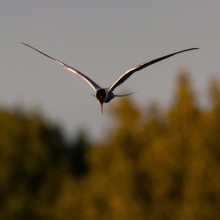
22:34 - Why bother migrating?
Why bother migrating?
Paul Walton, RSPB
Let’s consider migration - perhaps this brings to mind large mammals travelling across swathes of Africa. Or migrations that plunge into the water, from gargantuan blue whales to tiny zooplankton. So, why bother migrating at all, and how does it work? Phil Sansom asked Paul Walton from the RSPB...
Paul - I think it's really about two things. The first is survival. So for example, if you are an animal breeding in the Arctic summer, which is massively productive, there's lots of food around, there's lots of sunlight and that's great. But then when that summer is over, you've got kind of, nine months of ice and darkness, and very few animals can actually survive that. So it makes sense to move to other areas, where your survival chances are enhanced. So that's one thing. And I guess the other really big driver is the seasonality. Utilising temporarily available resources, in particular food. So there'll be blooms of algae, or blooms of insects, or fruits coming into season or seeds, for example, that are really there temporarily. And it's about moving to utilise those resources. I think broadly speaking, that's the drivers for these incredible movements.
Katie - Now, Paul, you're actually a seabird expert, aren't you?
Paul - Yeah, that's right. Yeah.
Katie - What are some of these journeys like?
Paul - Staggering, as far as seabirds are concerned, you know, here in Scotland, I worked in Shetland and Orkney, where there are breeding Arctic terns. Now the Arctic tern really is the longest distance migrant of any animal. So they go from the Arctic and sub-Arctic, where they breed, right down to the sort of, sub-Antarctic and Antarctic, but not just down to the bottom of the Atlantic, quite a lot of them go right round to the other site of Antarctica, which means they're actually going as far as they possibly could. They are going right round, literally halfway around the world, as far as they possibly could, before they come back. And one thing that really struck me is, working in Shetland, there's a midsummer in Shetland. It doesn't really get dark. The locals just called it the Simmer Dim. At night, it's just kind of like twilight, before it starts to get light again. So these birds are experiencing almost 24 hours of daylight when they're here breeding. But then of course it's the same when they go down South, and they're experiencing the Antarctic summer. So these are birds that really spend nearly all of their lives, in the light and in the air, it's quite beautiful really.
Katie - That's phenomenal. How do they know where to go?
Paul - That's a really, really good question. There's a mixture of things. So insects migrate, the Monarch butterflies over in the United States, that migrate down to just a couple of valleys in Mexico. And then there's our own Painted Lady butterflies. We've recently discovered they make a high altitude migration. Those animals, it's very unlikely there's any learned behaviour in there, it's instinctive. And I think for many birds, the corncrake is one bird that the RSPB has been studying for many years. It's got a complex migration pattern, that's only just emerged. But the birds only live for one or two years mostly. So their migration route is very likely to be an instinctive thing. For other animals, like the Arctic breeding geese. We know that they live longer and they hang out in family groups, sometimes for their whole lives. And it's very likely that young geese really need to learn the ins and outs of migration, not just the route to take, but the vital stopover points, where they can feed to make these long distance flights.
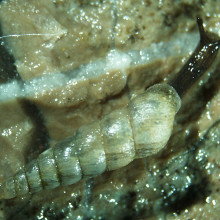
26:18 - Extraordinary snail migration
Extraordinary snail migration
Richard Preece, Cambridge University
Now not all migratory species have the capacity to cover great distances unaided. Back in 2006, Cambridge University mollusc expert Richard Preece published research of snails making a rather phenomenal journey, and he told Katie Haylor about his work...
Richard - Some have been shown to travel enormous distances as passengers on the back of birds or other organisms. The ones I'm about to tell you about are about a centimetre long, two or three millimetres in width; long, slender things called Balea. I was fortunate enough to go on an expedition to the Tristan da Cunha islands in 1982. I spent most of the time on an island called Inaccessible Island, which as the name suggests is rather a difficult place to get to! These are volcanic islands right in the middle of the South Atlantic, about midway between South Africa and South America. With my interest, I was obviously keen to look at the species of snail that occur on those islands and nowhere else. Very few people have had the opportunity to do any field work there. I was also keen to see what introduced snails and other things occur on those islands, given their extreme remote position.
Katie - And it turns out that Richard isn't the first to go looking for snails on this island.
Richard - In fact, the first person to have collected snails on Tristan was a chap called Captain Carmichael, sent out to Tristan with the initial garrison; because basically the founding human population there were sent there to try and deny the French a base from which to rescue Napoleon; so we're talking in the immediate aftermath of Waterloo, a British garrison was set up there. And he was obviously bored out of his mind, and he actually resorted to collecting snails amongst other things; and he found some of these snails that no one else had ever seen before.
Katie - The question of how land snails ended up on remote islands was one that Charles Darwin himself pondered.
Richard - He comes into the story in a general way, because one of the things that fascinated him was trying to address the huge problem - how on earth do land snails - with such proverbially poor powers of dispersal - how on earth can they get to such remote islands? And these are islands that are oceanic, so they've never had any connection with mainland at all; so they must have gained access to those islands through some sort of aerial means. And since they don't actually physically fly, some other mechanism must be involved. And this was a subject that fascinated him for years, and indeed his very last paper was written about dispersal in molluscs.
Katie - Richard explained that there are two groups of snails on Tristan - the recent imports, several European species that have got there under human agency, likely from South Africa where they've also been introduced; and then there are two families, Balea and Succinea, which belong to a much more ancient colonisation. And they don't swim; they don't fly; but somehow at least one brave specimen made its way all the way over from Europe. Could they have been stowaways on a boat visiting the island? Well, Chris Smith asked Richard this previously on the Naked Scientists, and Richard explained that since the islands were only discovered in 1506, the amount of variation that now exists couldn't have occurred in that timeframe. Instead, it seems they hitched a ride. So how does a little snail manage to hitch a ride on migratory bird, cling on rather than falling into the depths of the ocean, and not only survive, but thrive, on an island so far from home?
Richard - Well this is a very interesting question, and a lot of people have tried to explore this. There is a little book written in the 1890s trying to document all the cases of passive dispersal in land snails, land and freshwater snails. Bivalves are known to clip themselves on to the legs of intersects or newts; birds have been shot and snails have been found amongst the plumage; but others have been shown to travel through the gut of a duck or something like that, a wader, and have actually survived the passage in the live state. So that is obviously another mechanism.
Katie - Rather handily, these snails are hermaphrodites, allowing a lonesome snail to start a colony potentially. And Richard's done some DNA detective work to check these really are the descendants of European snails.
Richard - I collected material that we dissected, and we showed from the dissections that, in fact, they were anatomically indistinguishable from Balea, European Balea. And we followed that up by looking at some DNA from the snails from Tristan, and indeed, everything points to the fact that they are indeed Balea. That family does not occur in Africa or anywhere in between, so that there's no other source population from which they could have arisen.
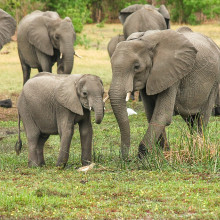
32:10 - What's a wildlife corridor?
What's a wildlife corridor?
Nina Bhola, UN Environment Programme World Conservation Monitoring Centre
Ecological corridors are routes that facilitate the free movement of animal life - be it a river linking fresh and saltwater habitats, or a man-made bridge built to minimise roadside fatalities. Nina Bhola is an ecologist from the UN Environment Programme World Conservation Monitoring Centre here in Cambridge, who looks at ways to manage land for the benefit of human development and biodiversity, and this corridor concept is important in the work she does. Phil Sansom and Katie Haylor spoke to Nina...
Nina - Ecological corridors are clearly defined areas that are managed for the long term to maintain or restore connectivity between protected areas and natural areas. They could be on land, freshwater, and marine ecosystems, or even in the air. They can be managed from small scales, to regional scales, to even continental scale; so thinking about ecological corridors that are managed to support migratory turtles or birds. There's clear guidance; it's been developed to support restoring and managing these corridors; and they take various forms. They could be from crossings built by people like bridges or tunnels to help wildlife cross safely. The routes could also be used by wildlife seasonally to reach water or food; for example, the movement of 1.5 million wildebeest migrating across the protected Mara Serengeti ecosystem that straddles the border between Kenya and Tanzania, for example. And it often takes many years for these animals to learn where to move in order to find food, and this behaviour is generally passed from generation to generation.
Phil - You've mentioned a lot of different types of corridors. Are they a particularly important concept, Nina?
Nina - Yes, it's a very important concept that planners and developers need to take into account. We're looking at our environment now today: human development has altered the natural areas in a variety of ways, causing these areas to become somewhat disconnected or fragmented. This has a really big impact on the movement of species and ultimately on their survival. There may be barriers that hinder this movement, like linear infrastructure such as roads or railways, or even fences that cut right through areas in which animals naturally move. The science shows that maintaining ecological corridors through connectivity conservation is essential for keeping species, populations, and ecosystems viable; and without connectivity, these ecosystems can't function properly, and without well-functioning ecosystems, biodiversity or nature is at risk. And when we talk about biodiversity, we're thinking about the variety of all life on earth, which actually underpins our lives: from the production of food, to clean water, to the health of our global economy. And we know that today the world is facing a global nature crisis, with up to almost a million species are now known to be threatened by extinction.
Katie - Nina, specifically you've been looking at how best to manage movement priorities between people and elephants in Kenya, haven't you? Tell us a bit about your project.
Nina - We have a project called the development corridor partnership, and the overarching aim of the project is really to investigate how human infrastructure impacts on animal movement, and to understand what we can do to minimise that impact. And so one specific element of the project looks at the ongoing phased development of an extensive railroad network, which is affecting the movement of elephants crossing between protected areas and their natural habitats in search of food. And really this first phase of the railway has established underpasses for animals; some parts of the railway have also been elevated to around 15 metres to allow elephants to move under; but we need to do a better job at understanding how these animals respond to these structures, especially as we know it takes a long time for them to recognise them, for them to know where the crossings are in the first place.
Katie - How much do we understand about the impact that climate change is having, or is likely to have, on animal movement? Because presumably, if the way animals move changes, then the way that land needs to be managed could change.
Nina - Absolutely. Climate change has real implications for wildlife corridors, because climate change can change the patterns of animal movements. Animals generally need to move in response to food availability, and when climate changes, with increasing droughts, it's just going to make it more and more difficult for animals to find this food. And that's why scientific data and modelling is so important. We need to be able to predict how animal movements might change in the future and plan accordingly. And this is also true for people: people are moving as climate change occurs. With this increasing human alteration, we need to think, and we need to act, at larger spatial scales, and therefore both planning and management need to consider well-designed ecological corridors that benefit both people and nature.
Katie - So what are the next steps for your Kenyan project?
Nina - It's really about the learnings: using science, using spatial models and maps, can actually help us to identify where animals cross. These results will be very useful to help inform a future phase that is being carried out to develop the third part of the railway network. And we've seen lots of successes in many parts of the world in both avoiding infrastructure, especially in highly sensitive areas. And so the results from this project have enormous potential to help planners and decision makers think about where future ecological corridors could be placed to help wildlife cross safely and protect vital landscapes.
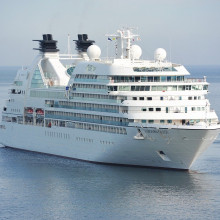
38:17 - Insect stowaways
Insect stowaways
Simon McKirdy, Harry Butler Institute Murdoch University
From animals moving by their own agency, let’s consider the other side of the coin, when us humans get involved in moving animals around. Invasive species - foreign species introduced by humans to a new habitat - are a major concern for maintaining the diversity of species on the globe, and whereas some cases of introductions are purposeful, many are accidental. Australia is well known for its unique wildlife, and much effort goes into protecting it with various measures to prevent and deal with invasive species to minimise the impact on native animals and plants, and subsequent impacts on society. This is known as biosecurity, and expert Simon McKirdy at Murdoch University in Perth, Western Australia, has recently analysed a 1,500 cabin cruise ship for stowaway insect life, to better understand the biosecurity risks posed by these global transport links to vulnerable habitats...
Simon - We've been heavily engaged in working with an island that has one of the world's largest natural gas plants on it. And when this project commenced, there was requirements put on by both our federal and state government, that the developers were not allowed to introduce a single what was referred to as a non-indigenous spaces or an invasive species to the island. The island was actually very much as it was pre the separation of this island from the mainland. So for more than 8,000 years, what's been living on that island was quite unique. And for some species that have become extinct on the mainland, this is their only last reserve. And so because of that, there's been very strict requirements put in place as to how that island would be protected.
In developing up a gas plant on the island, a decision was made to bring a cruise vessel, 1500 cabin size, bring it to the island to operate as an accommodation facility for more than 15 months. And because that vessel was operated for most of its working life in the Baltic, we then set up detailed surveillance on that vessel to find out what organisms were actually living on that vessel and what organisms might pose a risk to the island when the vessel arrived. We identified a number of insect species on the vessel that posed a significant risk not only to the Island, but also to Australia as a whole.
Katie - How do you go about surveying and monitoring that enormous boat?
Simon - We actually set up quite an extensive programme. We had scientists on board the vessel every day for that 19 months, extensive maps of the vessel. For the first period it was very much about looking over every part of the vessel in quite an intensive way. Part of that also included actually, you know, lifting carpet, dismantling wooden seating and things to try and get into any of the little holes and nooks where insects might live. And then through a process of starting to map where the insects were at a broad scale on decks, then to focus our efforts in on the particular decks where there was significant populations. So the insects that we were particularly concerned about, which were insects that are normally a concern with stored products, they were all around the decks where there had been bars in the previous life of the vessel - restaurants, dining rooms, nightclubs. So anywhere where people were consuming a lot of food or drink, that's where the insects would be. And our theory in the end on why we continued to find so many insects in those areas was just that when humans are there eating and drinking, we just naturally drop a lot of food and drink. And so it's the mix of, you know, the human detritus skin and that, that we just drop every day, food crumbs and spilt drinks that had become this long-term food source to keep these insects alive.
Katie - Were there any insects that were particularly successful stowaways?
Simon - Yeah, there was one in particular and it was the one that we actually considered was the biggest threat to Australia. And that was an insect called tribolium destructor, a tiny little beetle, we're only talking, you know, a beetle of about five millimetres in length. But despite all the effort we put into hunting for this beetle and baiting and trapping and chemical treatments, even at the end of the 19 months when that vessel sailed away, we had not managed to kill the population. We were still finding larvae on the last few days before it left. You know, we didn't eradicate the insect from the vessel, but what we did manage, and that was also an important part was, we didn't want the beetle to leave the vessel. If it left the vessel and then got introduced to the island and then to Australia, you know, that could have been a significant threat. So we set up a strong biosecurity system on the vessel where every single passenger that left the vessel had their luggage inspected. And we also did a lot of communication with the people that lived on the vessel, which were workers on the island, in communicating to them the importance of making sure they weren't carrying any of these insects as hitchhikers. And to make sure, you know, their luggage was clean when they left. And through that process, we were successful in making sure that the insect did not leave the vessel.
Katie - How would you summarise the significance of this work? Because it sounds like there aren't just lessons here to learn for Australia. Cruise liners go, well by definition, all over the world.
Simon - Yeah. Covid has thrown up an interesting discussion around cruise vessels and what they'll look like for the next, you know, few years. But what we had seen up to before Covid arrived was quite a rapidly increasing industry. And there was this need with passengers to keep visiting more and more remote locations. To us, the biggest message out of this - and from a biosecurity perspective, the concern - is that if we are going to allow cruise vessels to visit remote and vulnerable locations where we have very few or no invasive spaces, then we have to be very conscious of the risk that they may introduce pests into these areas. I don't think we should assume that just because from a surface view a cruise vessel looks very clean, it is possible that, you know, lurking underneath cleanliness layer is a population of insects that could pose a significant risk to a new area.
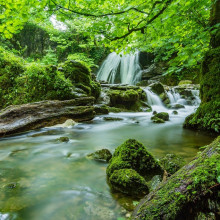
45:17 - Invasive species in the UK
Invasive species in the UK
Paul Walton, RSPB
So far in the show we’ve heard about animals moving themselves and each other around, and how human activity can result in some species being moved into new habitats where they can call real problems. So what can be done to address, or prevent, this happening in the first place? Phil Sansom spoke to the RSPB’s Paul Walton about the problem of invasive species in the UK...
Paul - When it comes to aquatic species here in the UK, I think there really is quite significant threat. Now, all environments on Earth can be subject to the impact of invasive non-native species. But some are particularly vulnerable. And that is islands, as we've been hearing from your previous contributors, but also other insular habitats like freshwater bodies or freshwater habitats in this country, the upland tarns, the chalk streams, our rivers, our estuaries are really potentially quite vulnerable.
There's a group of species that we call the Ponto Caspian freshwater species that evolved over in the Caspian Black and Azov sea area in East of Europe. And have actually in recent decades, been spreading across continental Europe, sort of en masse. And it's 20 to 30 species of aquatic plants and molluscs and crustaceans and small fish. But the thing is that they all co-evolve together and they all co-exist very successfully. And when some of them establish, it improves establishment conditions for the others. And they have been moved between water bodies by people simply moving things like angling gear and boats and canoes and other equipment between different water bodies. And you get eggs and propagules moved into new catchments and they've spread right across continental Europe.
Now there's maybe four or five of these species now already in this country. The dikerogammarus, the killer shrimp, which is established in some of the water bodies in south and central England. But there are sort of 25 of them sitting in the Dutch ports waiting to come over to this country. And so I'm really concerned that we need to improve our biosecurity in this country. It's fantastic hearing Simon McCurdy there talking about the immense detail that people are studying biosecurity over in Australia. We need to start to learn some of these lessons over here in the UK as well.
Phil - Is there any way of predicting what the future is going to look like and what our outlook's going to be?
Paul - In general terms there is. We can't predict exactly which species are going to come here, but the number one route of people directly moving either deliberately or accidentally species around the world, the main pathway is international trade. Okay. So we know that there's something we need to focus on around just being extremely careful about how we are moving animals and plants and fungi around the world in our trade. And we know in this country, post Brexit, clearly there are going to be new international trading relationships developed. So we are going to have naturally new arrays of species arriving. That is one issue, I think, that we need to have our eye on.
The other, I think, is that climate change, as it progresses and progress it will, is known to be improving the establishment conditions. So species may be brought here, but for example, they're going to start to find there's less frost for example, and that is going to allow more species to get that toe hold and to establish themselves in the wild once they either escape or are accidentally released, or are sometimes even deliberately released for one reason or another.
So I think with a combination of climate change and developing international trade, there is a real risk to this country from something which we know already is actually costing us - not only our precious ecological resources and biodiversity treasures, but - something like 2 billion pounds a year, just the management at the moment. I think the key lesson is prevention and biosecurity is the key. And at the moment we're simply not investing much in this country in biosecurity, less than a million pounds a year. We have been pressing with other environmental organisations for a significant increase in the spend on biosecurity for the UK and the establishment of an invasive species inspectorate to help people to adopt best practice with regard to biosecurity.
Phil - Any final reflections on the show as well, Paul? What should people take away about how animals move?
Paul - My reflections are really around the enormity of animal movements right across the different groups. It was fascinating to hear Richard Preece talking about Tristan da Cunha. Of course, one of the Tristan islands is Gough Island. It's a UK overseas territory. It is the last refuge of the fabulous Tristan albatross. And those birds are in severe decline because of being predated by non-native mice, which were introduced onto the island through shipping. The RSPB is engaged in a project to try to eradicate those mice and save that species from extinction. So there's a whole range of non-native species issues out there. When Nina described the global biodiversity crisis, she was really right. And invasive species are one of the five drivers of that. And it's just going to have to be an integral part of our response to that crisis. Is to be much smarter about the way human beings move animals and plants around the planet.
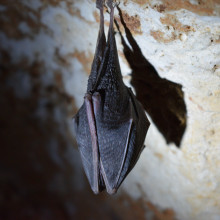
51:14 - QotW: How do bats roost upside down?
QotW: How do bats roost upside down?
Phil Sansom asked bat expert Brock Fenton...
Phil - Every one of our questions of the week goes on our science forum - that’s nakedscientists.com/forum - and Evan from Australia responded pointing out that most bats are pretty small, so there is very little distance the top and bottom of their bodies, certainly compared to humans, making pumping the blood that little bit easier. But the next few responses quickly moved onto the topic of bat excrement, so I left the forum to speak to bat expert Brock Fenton.
Brock - Many bats hang upside down, and in this posture show no negative impact on patterns of blood flow. But these bats look at us and worry about whether our blood all rushes to our feet!
Phil - In either case, humans or bats, the circulatory system has the important job of maintaining blood pressure across the body.
Brock - If our blood pressure drops too much, we suffer from an oxygen shortage, get dizzy, and pass out.
Phil - To avoid this, bats, like all mammals, have valves that prevent blood from rushing to the head - but the next challenge is to go from roosting to flying...
Brock - In either situation, the circulatory systems are designed to deal with changes in posture. Bats are very small mammals that undergo many changes in body posture as they fly. Their circulatory systems are adapted to smooth out the impacts of the changes, as ours do when we run and jump and move around.
Phil - So that’s a small body, a specialised circulatory system, and plus, bats also have very large hearts and lungs for their size, and astonishing heart rates to power their rapid flight - that go up to 20 beats per second!
Brock - But a fundamental question is ‘why hang upside down?’ For bats the situation is complicated. While most species/individuals do hang upside down, some do not.
Phil - Those that do rely on a particular arrangement of tendons so that they don’t have to tense their feet to hang - in fact, clenching for them becomes the relaxed posture, and they have to use a muscle to unclench. Why have they evolved like this…?
Brock - Hanging upside down allows a bat to take flight by simply letting go and dropping … spreading its wings and taking flight. This is much cheaper than trying to jump into the air, or making a long take off run. Why do bats really hang upside down then? I think it’s because they are lazy!
Phil - Western University’s Brock Fenton, taking bats to task. Next time, from animals to plants - with this question from listener Kevin...
Kevin - Does watering my veggie garden in the morning mean that water uptake will coincide with the intake of sunlight, and give my vegetables the best chance? Or is it just as good to water in the evening?
Phil - Do you know? If so, please come plant the seed of the answer on our forum - that’s nakedscientists.com/forum. Or if you have a question you’d like us to answer, email chris@nakedscientists.com, use the webform at nakedscientists.com/question, or find Naked Scientists on Twitter or Facebook. That’s all - until next time, goodbye!










Comments
Add a comment